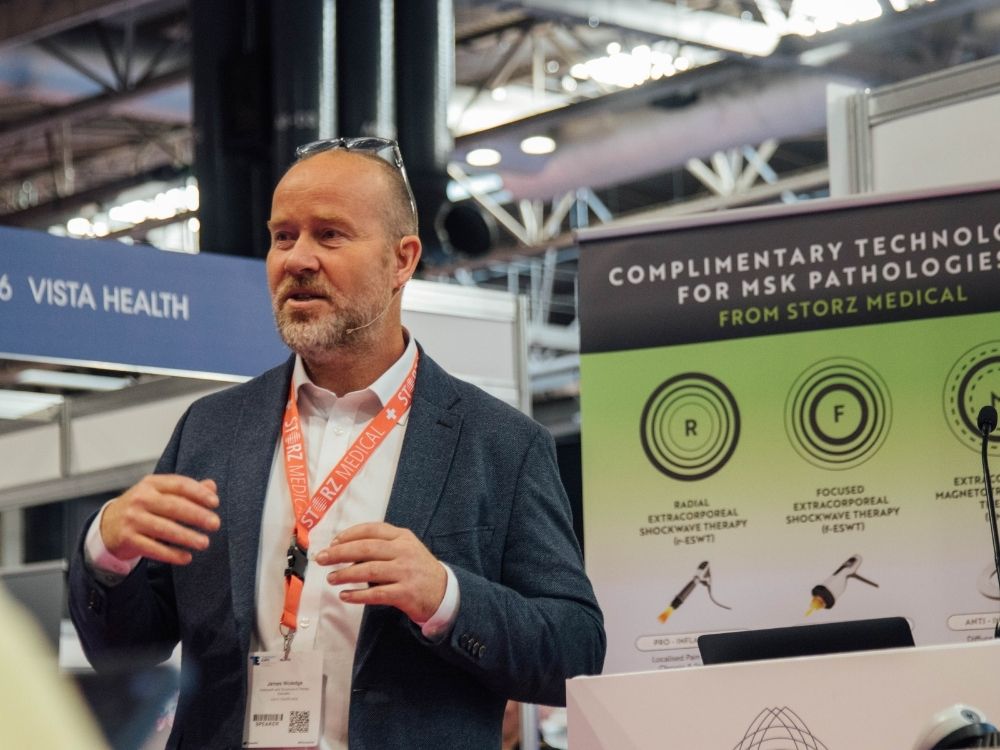James Woledge has been using shockwave therapy for nearly ten years and has been teaching and podcasting about it since 2017. He mentors beginners through to advanced practitioners using Storz Medical radial and focused devices. James runs two multi-disciplinary clinics in Suffolk and Kent.
You can find James at The Abbeyfields Clinic, ED Clinics & The Shockwave Therapy Podcast
How did you start your journey with shockwave therapy?
My journey with shockwave started in 2013 after becoming interested in plantar heel pain and Achilles tendon issues. Nearly everything works in the short-term, but patients kept coming back complaining of relapses. This may be good for repeat business but it’s not good for the soul, especially when you leave college thinking you have the skills to cure all ills. An old BSO friend had mentioned this soundwave thing, so I followed it up at one of the national trade shows. I got one to try for a few months so I could throw it at my list of stubborn plantar fasciitis patients.
Amazingly they were nearly all reporting their painful ‘first few steps’ had resolved after 1-2 sessions and remained so more than a month later. Anyone who treats these patients will know how significant that is. I did some research and decided to buy into one of the accepted leaders in the field – Storz Medical. I now own Radial and Focused devices across my clinics supplied by Venn Healthcare.

What percentage of your patients have shockwave treatments?
I would say that 50% of my patients are now ‘shockwave patients’. But this is because I have developed a patient list/practice that specialises in chronic tendinopathies and plantar fasciitis. Many patients are not candidates for shockwave and I’m a passionate advocate against using it on ‘everyone for anything’ just because you have a machine.
What conditions do you see the most?
I see an enormous number of lower extremity problems from plantar fasciitis to GTPS (gluteal tendinopathy) and shin splints. I am also starting to see more calcific tendonitis patients as I now use ultrasound imaging to assess all my patients.
What conditions do you think respond the best to shockwave therapy?
Certainly, plantar fasciitis and GTPS are the best responders and the most common. They are relatively easy to treat as they are easily accessed, plus patients tend to find the treatment less painful than other areas.
How has shockwave advanced your practice?
It has shone a light on many conditions we Osteopaths are historically poor at. I’m sure that might raise a few eyebrows but my undergraduate education on tendon related disease and its management was very little. Getting involved in shockwave encourages you to upskill in soft tissue-based pathology and evidence-based rehab strategies. I still combine traditional Osteopathic thought and skills to treat these conditions but I think it right that we should strive to increase our knowledge, based upon the evidence, to ensure we appropriately treat these patient groups. Shockwave has certainly broadened my practice life and kept me interested! If I was still seeing 20-30 lower back pain patients per week, I would be bored stupid. This week alone I will see one delayed tibial bone union (focused shockwave works well on these) 3 calcific tendonitis patients and 2 proximal hamstring tendinopathies. Alongside ultrasound imaging this is an exciting week for me!
As a well-respected educator on shockwave therapy, where do you see the future of the technology?
I think its mainstay will be in the MSK field but with an ever- growing list of evidence-based conditions such as chronic LBP, Mortons neuroma and shin splints. It’s no longer just a tendon machine. Its use in urology for example for Peyronie’s, CPPS and erectile dysfunction is becoming much more widely accepted and our clinic is typical of a trend that’s seen a year-on-year doubling of these patient groups.




